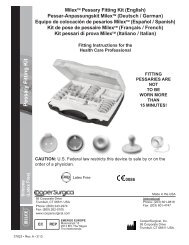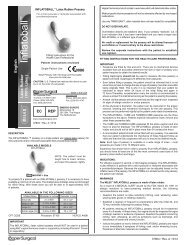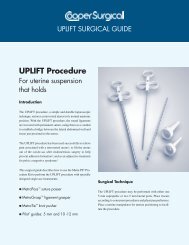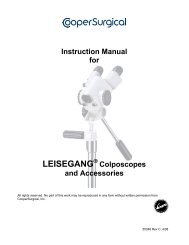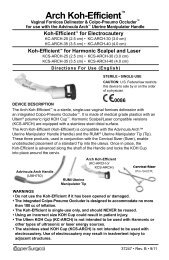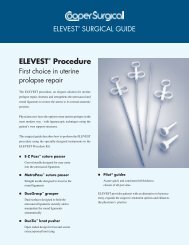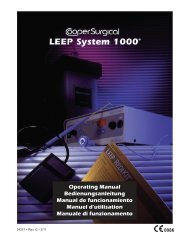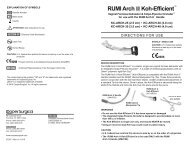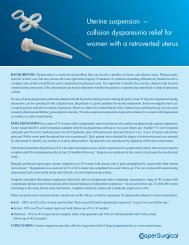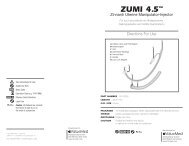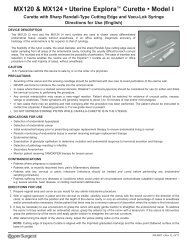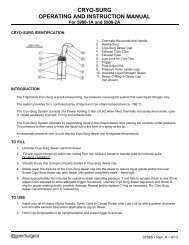LEEP System 1000® Workstation Operating ... - CooperSurgical
LEEP System 1000® Workstation Operating ... - CooperSurgical
LEEP System 1000® Workstation Operating ... - CooperSurgical
Create successful ePaper yourself
Turn your PDF publications into a flip-book with our unique Google optimized e-Paper software.
REMEMBER, THIS IS NOT AN ATTEMPT TO TEACH ELECTROSURGICAL TECHNIQUE.<br />
The practitioner who lacks experience should not attempt the procedures described below based solely<br />
on this information; instead, the skills required should be acquired in the time-honored preceptor manner.<br />
Call <strong>CooperSurgical</strong> for information on courses that offer instruction on the proper use of electrosurgical<br />
generators and accessories.<br />
NOTE: The best initial effect is accomplished with the cutting wire in only light contact with tissue. Light<br />
pressure may cause desiccation of the tissue and will delay the start of the cutting effect.<br />
If the use of other output modes is anticipated, repeat steps in Sections 6.1.3, 6.1.4 and 6.2 as desired.<br />
The output power level settings selected for each output mode will be retained as long as the Electrosurgical<br />
Generator remains ON.<br />
IMPORTANT<br />
The initial use of any electrosurgical generator always involves some degree of “trial and error”.<br />
This is true even when only changing from numbered dials to digital display models within the<br />
same manufacturer’s product line. As with any other therapeutic device, it is very helpful to<br />
experiment IN VITRO or on animal sample tissue before using any electrosurgical generator<br />
or methods which are not familiar.<br />
The microprocessor control system of the Electrosurgical Generator was developed specifically<br />
to provide the best possible performance for loop electrosurgical excision procedures. By<br />
exhibiting patience and following the guidelines offered, the practitioner should easily<br />
become familiar with the performance characteristics of the <strong>LEEP</strong> <strong>System</strong> 1000 ®<br />
Electrosurgical Generator.<br />
6.3 Thermal Effects on Tissue Treated with Loop Electrodes<br />
Thermal effects on tissue specimens may include:<br />
1) Thermal coagulation injury of the cervix, up to one-third the thickness of normal epithelium of the cervix;<br />
2) Fragmentation of squamous epithelium of the cervix attributable to long exposure periods along the<br />
excision site that allows heat to dissipate laterally;<br />
3) Partial coagulation of the endocervical epithelium because of lateral radiation of heat. Therefore, the Loop<br />
Electrosurgical Excision Procedure (<strong>LEEP</strong>) may produce thermal effects at the periphery of the excised<br />
tissue and may make histopathologic interpretation difficult or impossible and therefore, may not allow<br />
accurate diagnosis and may obscure the need for further treatment.<br />
Section 7<br />
Electrosurgical Precautions<br />
The safety and effectiveness of electrosurgery is dependent, to a large degree, upon the skill of the<br />
user/operator. It is important that the user/operator read, understand and follow the operating instructions<br />
supplied with the <strong>CooperSurgical</strong> <strong>LEEP</strong> <strong>System</strong> 1000 ® Electrosurgical Generator and thoroughly understand<br />
the principles and use of radio-frequency (RF) electrosurgical systems.<br />
WARNING: Electrosurgery uses radio-frequency energy to cut and coagulate tissue. Because of the sparking<br />
and heat associated with electrosurgery, do not use with flammable anesthetics or other flammable gases,<br />
near flammable fluids or objects, or with oxidizing agents.<br />
• DO NOT use electrosurgery in the presence of flammable gases, flammable liquids or flammable<br />
objects in oxygen-enriched atmospheres, in nitrous oxide (N 2 O) atmosphere or in the presence of<br />
other oxidizing agents.<br />
• Prevent accumulation of oxygen, nitrous oxide (N 2 O) and flammable gases under surgical drapes or<br />
within the area where electrosurgery is performed; moreover, avoid such accumulation in cases of<br />
thorax or head operations unless safely aspirated.<br />
• Verify that all oxygen connections are leak-free before and during the use of electrosurgery.<br />
• DO NOT use electrosurgery in the presence of naturally occurring flammable gases which may<br />
accumulate in body cavities such as the bowel.<br />
14 <strong>LEEP</strong> <strong>System</strong> 1000 ® <strong>Workstation</strong> • <strong>Operating</strong> Manual



